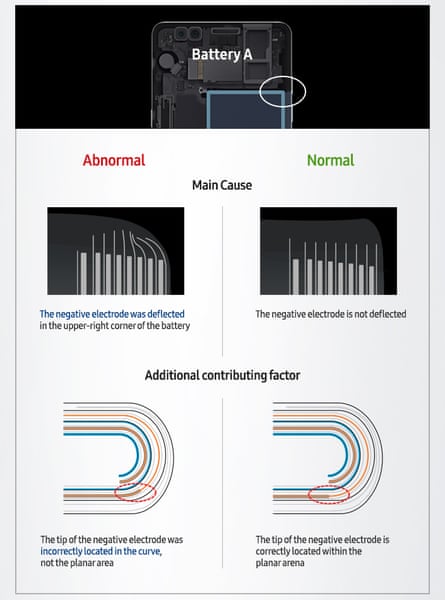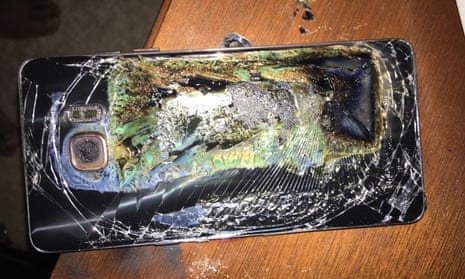Samsung has blamed lithium-ion batteries for causing its Galaxy Note 7 mobile phones to overheat and catch fire, a fault that led to the global recall of millions of devices and damaged consumer confidence in the world’s biggest maker of smartphones.
At a press conference on Monday, Samsung officials said exhaustive tests on tens of thousands of devices and batteries had ruled out any problems with the device’s hardware or software.
But, it added, internal and independent investigations had “concluded that batteries were found to be the cause of the Note 7 incidents”.
In the case of the original battery, the casing was too small, causing it to short-circuit and ignite. It was replaced with a battery that had a different manufacturing defect but led to the same result.
Koh Dong-jin, the head of Samsung’s mobile business, told reporters in Seoul: “We sincerely apologise for the discomfort and concern we have caused to our customers.”
The company said there would be no fire risk involving future devices, including its forthcoming S8 smartphone.

“We are taking responsibility for our failure to ultimately identify and verify the issues arising out of battery design and manufacturing,” it said in a statement. “We have taken several corrective actions to ensure this never happens again.”
The South Korean conglomerate promised to reform its production and quality controls to prevent a repeat of the incident: “We look forward to moving ahead with a renewed commitment to safety. The lessons of the past several months are now deeply reflected in our processes and in our culture.”
Samsung was forced to recall more than 2.5m Note 7s in September after reports that they were overheating and catching fire. The crisis deepened when it emerged that replacement phones equipped with batteries from a different supplier were experiencing similar problems.
The company permanently ended production of its flagship smartphone in October – a move that is expected to cost the company an estimated $5.3bn in lost profits.
Samsung said it had spent several months investing “all of our efforts and substantial resources” into determining the cause of the incidents.
“Our investigation examined every aspect of the Galaxy Note7 including hardware and software, and related processes, such as assembly, quality assurance testing, and logistics,” it added.
According to the firm, 700 engineers and researchers conducted tests on more than 20,000 fully-assembled Galaxy Note 7s and more than 300,000 batteries.

The problem with the lithium-ion battery used in the original batch of Note 7s was traced to its internal structure, which comprises layers of positive and negative electrodes.
In some cases, the battery was squashed in one corner, forcing the tips of the layer of negative electrodes to curve over, Samsung said.
In the replacement batteries, which came from a different supplier, the fires were caused by punctures in a super-thin component that separates the positive and negative electrodes, and faulty insulation.
Despite the Note 7 safety scare, Samsung is expecting its fourth-quarter operating profits to reach their highest level in almost three years thanks to healthy microchip sales.
Analysts said consumers would only be convinced by a conclusive explanation of the cause of the fires, as Samsung prepares to release the S8 this spring.
“Consumers will not be reluctant to buy the S8 … only if Samsung clearly finds out what caused the fires,” Hi Investment analyst Song Myung-sup told Reuters.
